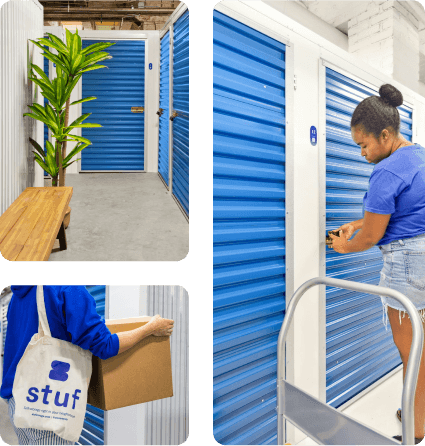Self-storage unit prices aren’t one-size-fits-all. They fluctuate based on location, unit size, technology, demand, and even the time of year you book. And while the national average provides a helpful benchmark, hidden variables like online discounts, climate control, and market trends in secondary cities can make all the difference in what ends up on your monthly bill. In this guide, we’ll break down what you’ll be paying for your self-storage costs in 2025 and the factors influencing this cost.
The Average Storage Unit Cost in 2025

In 2025, self-storage prices in the U.S. continue to vary based on several factors, including unit size, location, and amenities. On average, monthly rates are as follows:
- 5x5 unit: $50–$100
- 10x10 unit: $100–$150
- 10x20 unit: $160–$450
Climate-controlled units, which maintain consistent temperature and humidity levels to protect sensitive items, typically cost 20–50% more than standard units. For instance, a climate-controlled 10x10 unit may range from $150 to $250 per month.
What Factors Influence What You’ll Pay?
Self-storage pricing in 2025 is influenced by a multifaceted array of factors. Understanding these elements can help you navigate the market more effectively and secure the best value for your storage needs.
1. Unit size and type
The size of the storage unit is a primary determinant of cost. Larger units naturally command higher prices due to the increased space. Additionally, specialized units, such as climate-controlled spaces, often come at a premium.
2. Location and market demand
Geographical location significantly impacts storage costs. Urban centers with high real estate values typically have higher storage rates compared to suburban or rural areas. Moreover, areas experiencing population growth or housing shortages may see increased demand for storage, driving up prices.
For example, regions like Florida and Arizona are witnessing growth due to population increases and the shift to remote work, influencing storage demand and pricing.
3. Rental duration and commitment
The length of your rental agreement can influence the monthly rate. Long-term commitments often come with discounted rates, while short-term or month-to-month rentals may be priced higher due to the flexibility they offer.
4. Facility amenities and security features
Facilities offering advanced amenities such as 24/7 access, enhanced security systems, on-site management, and digital conveniences may charge higher rates. At Stuf Storage, for instance, the facility is guarded by 24/7 AI-powered security camera. Features like these provide added value and peace of mind, justifying the increased cost for many renters.
5. Online vs walk-in rate
In 2025, there's a notable disparity between online-listed rates and in-person (street) rates. Online rates often feature promotional discounts, making them more affordable than the rates you'd get by walking into a facility without prior research. Recent industry data shows that publicly traded self-storage companies, known as REITs (Real Estate Investment Trusts), offer online rates that are on average up to 40% lower than the rates you'd get by walking into the facility without a reservation. This is a significant jump from even the height of COVID-era discounts, which peaked at around 30%. Independent or non-REIT operators also follow this trend, though the gap is slightly smaller. On average, their in-person rates are about 18% to 30% higher than what they list online. For renters, this means one thing: always check the website before you visit in person. Booking online can lead to meaningful savings, especially over long-term rentals.

6. Seasonal demand fluctuations
Storage unit prices are subject to seasonal fluctuations. During peak moving seasons, typically from May to September, demand increases, leading to higher prices. Conversely, during off-peak months, prices tend to decrease.
7. Technological advancements
The integration of technology in self-storage facilities, such as contactless access, online reservations, and digital payment systems, enhances customer experience and can influence pricing. Facilities that incorporate these technologies often operate more efficiently, potentially passing savings on to customers. Moreover, features like AI-driven surveillance and digital key access add convenience and security, which may justify higher rates at tech-forward facilities
Hidden Fees and Pricing Surprises to Watch For
On the surface, a storage unit might seem like a simple monthly expense but once you dig in, the true cost can be more complex. Many storage companies have additional fees that aren’t clearly advertised upfront. Understanding these hidden costs can help you avoid budget busters and choose a facility that’s transparent and fair.

1. Administrative and setup fees
Most storage companies charge a one-time administrative or setup fee at move-in, which typically ranges from $15 to $30. While this might be listed in fine print online, it’s often glossed over in headline pricing.
This fee usually covers:
- Account setup
- Facility access activation
- Sometimes a lock — but not always. Ask in advance if it’s included and whether it’s refundable under any circumstances.
Stuf Storage takes a different approach. Unlike many competitors, Stuf Storage does not charge any administrative or setup fees. The company offers fully transparent pricing with no hidden costs, ensuring customers know exactly what they’re paying for from the start.
2. Mandatory insurance requirements
Many facilities require customers to carry insurance for the contents of their units and for good reason. Insurance helps protect against unexpected events like theft, fire, or water damage, offering peace of mind that belongings are covered.
For those without a homeowner’s or renter’s policy that extends coverage to storage units, facilities typically offer affordable options starting around $10 to $20 per month.
Even if existing coverage is in place, some providers may still offer in-house insurance plans for added convenience and security.
3. Late fees and lock-out penalties
If you miss a payment, some facilities will charge late fees of $10 to $30. After a grace period, you may be locked out of your unit, and access may not be restored until your balance is cleared. Some locations also charge re-entry or reactivation fees. Always check the late payment policy, especially if you’re storing critical belongings or running a business from your unit.
4. Exit fees and move-out rules
Most facilities don’t charge an official move-out fee, but they may require advance notice (often 10–15 days) to avoid being billed for the next month. Failure to comply could mean paying for time you didn’t need. Always review the cancellation policy carefully, especially for month-to-month rentals.
Commercial and Business Storage: Do Costs Differ?
If you're a business owner considering off-site storage in 2025, you're likely to get different prices from those of a residential renter. Commercial and business self storage costs often come with different pricing structures, expectations, and perks that can both add to and reduce your total cost of ownership.
Why does self-storage for business storage often cost more
While unit size is a core pricing factor, several business-specific needs can drive up the cost:
- Larger Units or Multiple Spaces: Businesses often require more square footage to store inventory, equipment, documents, or supplies. Naturally, larger or multiple business storage means higher base costs.
- Premium Access Requirements: Extended or 24/7 access, often a must for businesses, may come at a premium. Some facilities also charge more for drive-up access, which is preferred for frequent loading and unloading.
- Enhanced Security Features: Companies using business storage for inventory storing or sensitive data may need higher-security units (e.g., individual alarms, video surveillance, coded access), which can influence pricing.
-
Insurance Considerations: Commercial inventory may need higher coverage limits or specialty insurance, increasing monthly costs compared to typical residential content coverage.
Pro tip: Some facilities offer tiered pricing for business customers, bundling in security or longer-term discounts, which is why it's essential to ask about business-specific packages during your search.
Where You Might Save: Flexibility and Value Add
Interestingly, some businesses pay less per square foot in the long run due to longer lease terms or higher unit turnover:
- Volume Discounts or Long-Term Rates: Businesses willing to commit for 6–12 months may get more favorable rates, especially in slower rental seasons.
- Tax Deductions: Unlike personal renters, commercial storage fees are often tax-deductible as a business expense.
- Operational Efficiency: Offloading storage needs to a third-party provider means fewer on-site overhead costs, freeing up physical and financial space in your core business location.
How to Save on Self Storage in 2025

Understanding current trends and leveraging available discounts can lead to significant savings. Here's how to maximize value in today's market:
1. Book online to access discounted rates
Online bookings often come with promotional discounts. According to Stortrack’s most recent survey, online rates have continued to be on a downward trend over the past few years. In the last half of 2024, online rates were approximately 17% lower
2. Time your rental strategy
Storage demand peaks during the summer months due to a combination of factors,
including increased moving and cleaning activity, as well as seasonal events like vacations and school breaks. This often leads to an increase in storage unit prices. If possible, schedule your rental during the off-peak seasons (fall and winter) when rates are generally lower.
3. Choose the right unit size
Accurately assess your storage needs to avoid paying for unnecessary space.For instance, if you’re just storing a few boxes of seasonal decor and out of season items, small units ranging from 3x5s to 5x10s could be ideal for you. On the other hand, if you’re storing larger items such as furniture and kitchen appliances, unit sizes in the range of 10x15 or 10x20s could be the perfect size for you.
4. Inquire about long-term rental discounts
Many storage facilities offer discounts for long-term commitments. For example, if you pay for several months in advance, you can save up to 10%–15% in some storage companies.
5. Look for price-lock guarantees
Some storage providers like Stuf Storage offer price-lock guarantees, ensuring your rental rate remains unchanged for a specified period. At Stuf Storage, you can opt to add Stuf blue to your storage package. This 12-month price lock lets you stay in full control starting at $10 a month. You can also cancel anytime at no cost. This can protect you from unexpected rate increases during your rental term.
6. Avoid unnecessary add-ons
Evaluate whether you need additional features like climate control or 24/7 access, as these can increase costs. If you're storing items that aren't sensitive to temperature fluctuations, a standard unit may suffice.
7. Read the fine print
Before signing a rental agreement, carefully review the terms and conditions. Be aware of any hidden fees, such as administrative charges, insurance requirements, or penalties for late payments and early termination.
Store Smarter in 2025
By understanding what affects self storage cost, from seasonal demand to digital booking strategies, you’re in a stronger position to find a space that fits both your budget and your lifestyle. Whether you're making room for a growing family, managing a business, or planning a move, smart storage decisions start with knowing your options. Ready to take the guesswork out of storage? Explore Stuf Storage for transparent pricing, modern features, and a seamless experience, no surprises, just smart space solutions.









